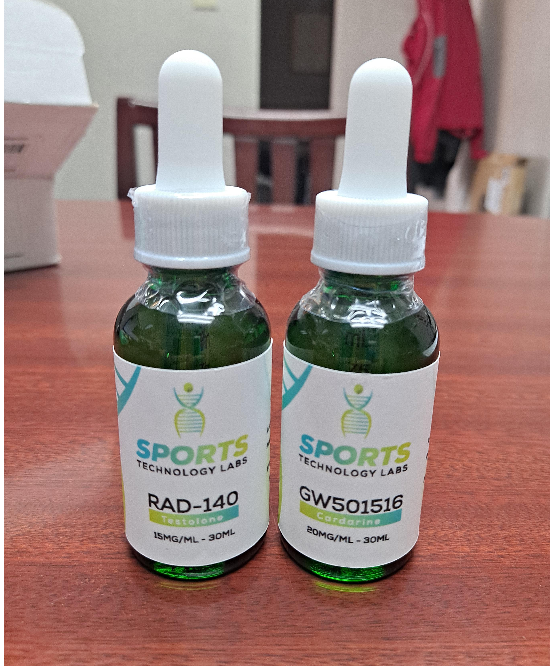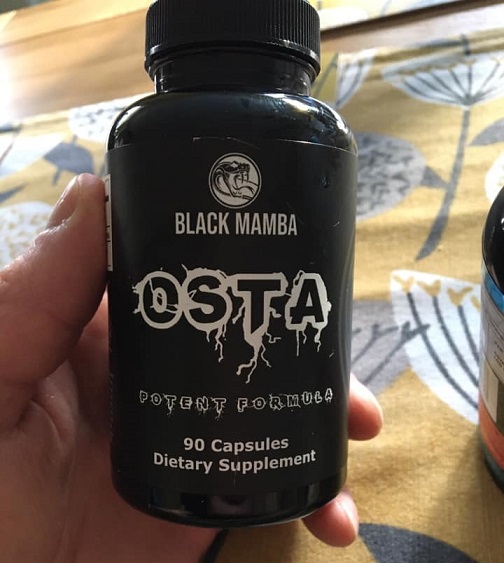Ostarine vs RAD 140: Which is the Better SARM?
 Disclaimer: SARMs are only to be used for research purposes, as they are non-FDA-approved compounds and thus may cause adverse effects. If you have any questions or concerns, Dr. Touliatos is currently available for consultation.
Disclaimer: SARMs are only to be used for research purposes, as they are non-FDA-approved compounds and thus may cause adverse effects. If you have any questions or concerns, Dr. Touliatos is currently available for consultation.
Selective androgen receptor modulators (SARMs) are investigational drugs formulated as a superior treatment to anabolic steroids in medicine.
SARMs’ are designed to promote anabolism in the body (1), via stimulation of the androgen receptor. However, they are to do so without the harsh side effects of anabolic steroids, which can be controlled via tissue selectivity (2).
Ostarine and RAD 140 are two popular SARMs, albeit with key differences.
Contents
Ostarine vs RAD 140 Benefits
Muscle Gains
Ostarine is considered a mild SARM, often taken by beginners who want to build up to 10 pounds of lean muscle while burning fat.
However, Ostarine’s effects on women differ from men, with Ostarine being a potent muscle-builder in females (who can gain over 20 lbs of LBM).
We have found RAD 140 to be a harsher SARM than Ostarine, with RAD 140 often being utilized when bulking, with the common objective being to build significant amounts of muscle and strength. Users can expect to gain up to 14 pounds of lean muscle on RAD 140.
Strength
Ostarine significantly increases muscular strength, albeit not to the same degree as RAD 140.
In our experience, RAD 140 is one of the most potent SARMs for increasing strength, with only YK11 or S23 being comparable. RAD 140 even rivals some of the most potent AAS (anabolic-androgenic steroids) in this regard. We have had RAD 140 users report extraordinary strength gains, such as adding 65 pounds to their bench press or 90 pounds to their leg press from a first cycle (3).
Fat Loss
There is a general consensus that Ostarine is a more suitable SARM when cutting due to its lipolytic (fat-burning) properties.
However, in practice, Ostarine and RAD 140 will burn a similar amount of fat. The reason why Ostarine users will appear leaner after a cycle is because RAD 140 users often adopt a high-calorie diet. Consequently, RAD 140 users are more susceptible to short-term water retention and bloating, which will obscure muscle definition on-cycle.
Disclosure: We do not accept any form of advertising on Inside Bodybuilding. We monetize our practice via doctor consultations and carefully chosen supplement recommendations, which have given our patients excellent results.
Best SARMs Company in 2023

Sports Technology Labs is our #1 rated source for SARMs, due to them consistently formulating products at >98% purity (authenticated via independent certificates of analysis).
Sports Technology Labs is one of the few companies to stock every SARM. They also have a 0% credit card fee policy (other sources charging up to 10%).
Discount code: Save 15% on Sports Technology Labs' SARMs by using discount code inside15.
Ostarine vs Rad 140: Side Effects
RAD 140 is the more potent SARM, so it is likely to cause harsher side effects.
Testosterone Suppression
Many men and women on Ostarine do not run a PCT (post-cycle therapy), as they do not typically experience hypogonadal symptoms.
However, individuals often run a PCT following RAD 140, as it is considered to be very suppressive.
We have experienced people being clinically diagnosed with hypogonadism from RAD 140 (with drops from 750 to 193 ng/dL) via a 12-week cycle.
Note: We are aware that a few Ostarine users have reported total testosterone levels dropping by as much as 70%; thus, this SARM may be more suppressive than first thought (at least for some individuals).
We find endogenous testosterone levels will naturally recover several weeks post-cycle. If someone is clinically hypogonadal, this process may take 1-2 months. A post-cycle therapy consisting of Nolvadex or Clomid will aid in the restoration of the HPTA (hypothalamic-pituitary-testicular axis), shortening recovery time.
Cholesterol
Ostarine will decrease HDL (high-density lipoprotein) cholesterol, causing a moderate increase in blood pressure.
In just 3 days, one Ostarine user’s systolic blood pressure increased from 120/75 mm/Hg (pre-cycle) to 148/84 mm/Hg (4).
With RAD 140 being the more potent SARM, we typically see it cause larger fluctuations in cholesterol.
One user’s blood pressure rose from 110/60 mm/Hg to 155/98 mm/Hg after taking 20 mg/day of RAD 140 (5). He also experienced numbness and pain in his chest region.
Thus, it is not advised to take Ostarine or RAD 140 if a person is experiencing hypertension, as both of these compounds will increase the risk of myocardial infarction.
Research also indicates that the dose of RAD 140 or Ostarine can determine how elevated a user’s blood pressure will be (6).
Liver Toxicity
From our patient LFTs (liver function tests), it is clear that SARMs are hepatotoxic and will raise ALT/AST values.
A 49-year-old man was diagnosed with hepatocellular-cholestatic liver injury after taking RAD 140 for just 4 weeks (7), with sporadic use afterward. He had also been taking an anti-depressant (venlafaxine) for 11 months prior to his RAD 140 cycle.
Thus, it is advised that antidepressants or other hepatotoxic supplements or medications should not be combined with SARMs.
A man also experienced cholestatic injury after just 3 weeks on Ostarine (8). He suffered from jaundice but recovered 3 months after cycle cessation.
If anyone does take RAD 140 or Ostarine, they should supplement with TUDCA at 500 mg/day and monitor their liver enzymes throughout their cycle. Alcohol should also be strictly avoided to minimize hepatic stress.
Results Comparison
Although RAD 140 is the stronger SARM, we have seen Ostarine transformations be just as impressive due to users adopting a calorie-deficit diet (and thus burning more fat).
When users are simultaneously burning fat via their diet and taking Ostarine for several weeks, muscle definition becomes significantly enhanced, vascularity becomes more prominent, and abdominals become more visible.
In contrast, RAD 140 users are less likely to prioritize fat loss via their diet, opting instead for higher calories to encourage anabolism.
RAD 140

The above user took a low dosage of 10 mg/day of RAD 140 for 8 weeks. Despite eating a small calorie surplus, his body fat has decreased notably. He has also experienced improvements in muscle hypertrophy, gaining approximately 10 pounds on the scales.
If he had increased his dosage to 20 mg/day, he would have experienced enhanced muscle gains and fat loss. 10 mg/day is a dose more suitable for women. However, side effects will be less severe with a lower dosage.
Ostarine

The above user cycled Ostarine for 45 days, at 20 mg/day. He lost 7 pounds on the scales but has simultaneously gained a notable amount of lean muscle (particularly in the deltoids and arms).
Dosages

Men typically take 10–20 mg/day of Ostarine, with women taking 5–10 mg/day. The upper range of these dosages is more common.
RAD 140 dosages are the same as Ostarine, which testifies to RAD 140 being the more potent SARM mg for mg.
Price Difference
- Ostarine: $49.99 (25mg/mL – 30 mL)
- Rad 140: $59.99 (15mg/mL – 30 mL)
*Prices taken from Sports Technology Labs.
RAD 140 is considerably more expensive than Ostarine per mg. If RAD 140 came in the same mg values per ml as Ostarine (above), it would cost just under $100 (at 25 mg/ml), compared to Ostarine’s $50.
Conclusion
In terms of benefits, we have found RAD 140 to be a superior SARM to Ostarine.
However, in terms of safety and severity of side effects, Ostarine is the milder compound.
Thus, Ostarine is more suited for beginners who have never taken SARMs before.
They both possess the same effects in regards to improving body composition, but because RAD 140 is more anabolic, it is perceived as a more suitable bulking compound.
It is also worth noting that RAD 140 is approximately double the price of Ostarine.
RAD 140 should ideally be taken once a person has already completed a SARM cycle, so that their body will be more conditioned and capable of tolerating harsher side effects.
Co Authors :
References
(1,2) https://www.ncbi.nlm.nih.gov/pmc/articles/PMC2907129/
(3) https://www.reddit.com/r/sarmssourcetalk/comments/fp4nbc/rad_140_results_with_questions/
(5) https://www.reddit.com/r/sarmssourcetalk/comments/j6end8/high_bp_on_rad_140gw/
(6) https://www.ncbi.nlm.nih.gov/pmc/articles/PMC4018048/



